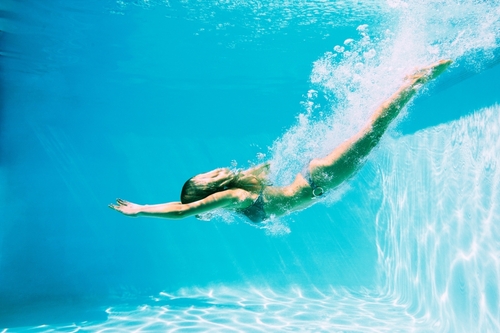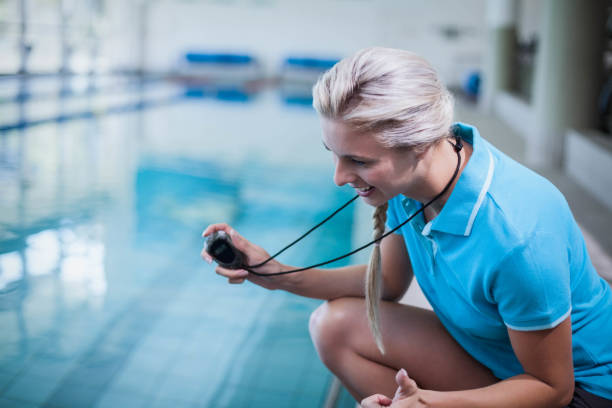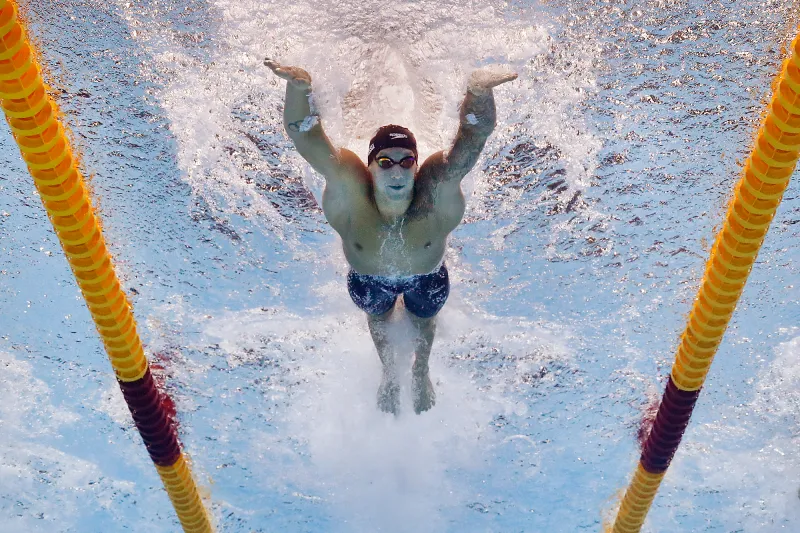Swimming is a great exercise that offers numerous benefits to both physical and mental health, including improved cardiovascular health, increased flexibility, and reduced stress levels. Swimmers also experience a low-impact workout that is easy on the joints, making it suitable for people of all ages and fitness levels.
Engaging in regular swimming sessions not only helps in weight loss and toning of muscles but also enhances lung capacity and improves overall endurance. The buoyancy of the water supports the body, reducing the risk of injury while allowing for a wide range of movements.
With its combination of cardio and strength training, swimming is a versatile workout that provides a variety of health advantages to individuals seeking a holistic fitness routine.

Credit: plungesandiego.com
Why Swimming Is The Ultimate Full-body Workout
Swimming is not just a fun leisure activity; it is also a fantastic way to achieve a strong and toned body. Unlike most other exercises that focus on specific muscle groups, swimming engages and works out nearly every muscle in your body. From your arms and shoulders to your core, legs, and back, swimming provides a thorough workout that targets multiple muscle groups simultaneously. Dive into the world of swimming, and you’ll soon discover its incredible benefits.
Swim Your Way To A Strong And Toned Body
Swimming is a low-impact, high-resistance exercise that helps build strength and tone muscles. As you glide through the water, propelling yourself forward with each stroke, your body must overcome the resistance provided by the water. This resistance forces your muscles to work harder than they would on land. Whether you’re doing freestyle, breaststroke, backstroke, or butterfly, each stroke engages different muscles. Your arms, shoulders, chest, and back get a great workout as they power you through the water, while your core and legs work to maintain balance and propel you forward. Consistent swimming will leave you with a well-defined, sculpted body that you’ll be proud to show off.
Burn Calories And Shed Pounds With Every Stroke
If you’re looking for an effective way to burn calories and shed those extra pounds, swimming is perfect for you. As a full-body aerobic exercise, swimming increases your heart rate and helps you burn a significant number of calories. The water’s buoyancy reduces stress on your joints, making swimming a fantastic option for those recovering from injuries or with joint limitations. Regardless of your fitness level, swimming allows you to exercise longer and more intensely, helping you achieve your weight loss goals. So dive in and start torching those calories, stroke by stroke!
Increase Your Cardiovascular Endurance In The Pool
Swimming is an excellent way to improve your cardiovascular endurance. The constant movement against the resistance of the water forces your heart and lungs to work harder to supply oxygen to your muscles. Regular swimming sessions help increase your lung capacity, making your respiratory system more efficient. This boost in cardiovascular endurance not only improves your overall fitness but also enhances your body’s ability to perform other physical activities. So jump into the pool and dive deep into a workout that strengthens both your body and your heart.
A List of 50 Super Healthy Foods: Transform Your Health with These Power-packed Foods!
Dive Into The Mental Health Benefits Of Swimming
Discover the mental health benefits of swimming and how it can improve your well-being. Dive into the positive effects of this refreshing exercise on your mind and mental state.
Swim Your Way To Stress Relief And Relaxation
` Swimming is not only a great physical exercise, but it also offers numerous mental health benefits. One of these benefits is stress relief and relaxation. When you dive into the water, the soothing sensation of the water enveloping your body can instantly melt away the tensions and worries of the day. The rhythmic nature of swimming strokes combined with the weightlessness you experience in the water creates a calming effect on your mind. By focusing on your breathing and the movements of your body in the water, you can release mental and emotional stress, allowing yourself to enter a state of deep relaxation. Whether you choose to swim for leisure or engage in more intense training sessions, swimming can become your go-to activity for finding respite from the hustle and bustle of daily life. `
Boost Your Mood And Combat Anxiety With Swimming
` In addition to stress relief, swimming has the power to boost your mood and combat anxiety. When you swim, your body releases endorphins, which are natural mood elevators. These hormones help reduce feelings of sadness, anxiety, and depression, leaving you with an overall sense of well-being. Regular swimming sessions can regulate your serotonin levels, which are responsible for regulating your mood and sleep patterns. Swimming can also act as a distraction from negative thoughts or intrusive thinking patterns, allowing you to focus solely on the rhythmic movements of your body in the water. So, the next time you feel overwhelmed or anxious, consider taking a dip and let the water do its magic in lifting your spirits and calming your mind. `
Improve Your Mental Clarity And Focus Through Swimming
` Not only does swimming offer relaxation and mood enhancement, but it can also improve your mental clarity and focus. When you engage in swimming, the controlled breathing required helps oxygenate your brain and enhances cognitive abilities. The repetitive nature of swimming strokes can also have a meditative effect, clearing your mind of clutter and promoting mental clarity. The immersion in water diminishes external distractions, providing you a serene environment to concentrate on your thoughts or even come up with new ideas. The solitude and tranquillity of the water make it an ideal setting to find your focus and enhance your mental productivity. Whether you’re seeking to find inspiration or simply desire a break from the constant stimulation of daily life, swimming can be an effective tool to sharpen your mental clarity and boost your focus. Swimming not only offers physical benefits but can significantly impact your mental well-being as well. By indulging in this timeless activity, you will not only reap the rewards of stress relief, mood elevation, and improved mental clarity but also find a renewed sense of calm and tranquillity. So, dive into the mental health benefits of swimming and experience the positive impact it can have on your overall well-being.
The Healing Power Of Water: Swimming For Rehabilitation
Swimming is not just a fun recreational activity; it possesses the healing power of water that can greatly aid in rehabilitation. Whether you’re recovering from an injury or dealing with chronic pain and limited mobility, swimming provides a low-impact exercise that offers numerous benefits. In this post, we will explore the various advantages of swimming for rehabilitation and how it can improve your joint health, speed up recovery, and strengthen your muscles.
Use Swimming As A Low-impact Exercise For Joint Health
Swimming is an ideal low-impact exercise for maintaining joint health and reducing stress on your body. The buoyancy of water reduces the impact on your joints, allowing you to engage in physical activity without putting excessive strain on them. The gentle resistance provided by the water helps to build joint strength and flexibility while minimizing the risk of further injury. Unlike high-impact exercises like running or weightlifting, swimming allows you to work out without aggravating existing joint problems, making it perfect for individuals with conditions such as arthritis or joint inflammation.
Speed Up Recovery And Rehabilitation With Aquatic Therapy
Aquatic therapy, often incorporated into rehabilitation programs, utilizes the healing properties of water to speed up recovery. The unique properties of water, such as buoyancy and hydrostatic pressure, assist in reducing swelling and inflammation. It also promotes blood circulation and aids in flushing out toxins from your body. Incorporating swimming exercises into your rehabilitation routine can help improve range of motion, decrease pain, and facilitate faster healing of injured tissues.
Build Strength And Improve Mobility In The Water
Aside from being a gentle exercise for joint health, swimming also offers an effective way to build strength and improve mobility. The resistance provided by the water engages various muscle groups, helping you develop lean muscle mass and improve overall strength. The continuous movement and water resistance challenge your muscles more effectively than traditional land-based exercises. Moreover, swimming allows you to exercise in a weightless environment, enabling those with limited mobility to move freely and adopt a wider range of motion that may be challenging on land.
Unlock the Key to Heart Vitality | Advice from Leading Heart Specialists
Unlock The Secrets Of Swimming For Longevity
Discover the remarkable benefits of swimming for longevity. Enhance your fitness and improve cardiovascular health with this low-impact exercise that promotes flexibility, strength, and overall well-being. Dive in and unlock the secrets to a healthier and more active lifestyle.
Discover How Regular Swimming Can Extend Your Lifespan
Unlock the secrets of swimming for longevity and enhance your overall health and well-being. Regular swimming is not only an excellent form of exercise but also has numerous benefits that can extend your lifespan. Whether you are a beginner or an experienced swimmer, diving into the pool can provide you with a host of advantages.
Swimming is a low-impact activity that puts minimal stress on your joints but yields maximum results. It engages your entire body, working out muscles that may be neglected in other forms of exercise. As a result, swimming enhances your cardiovascular endurance, improves your lung capacity, and strengthens your heart.
| Benefits of Swimming for Longevity |
|---|
| Burns calories effectively, aiding in weight management |
| Reduces the risk of chronic illnesses such as heart disease, diabetes, and stroke |
| Increases flexibility, balance, and coordination |
| Improves muscle tone and strength |
| Enhances mental wellness and reduces stress |
| Boosts your immune system |
Swimming is a versatile activity that can be tailored to your fitness level and goals. Whether you prefer a leisurely swim or an intense workout, you can adjust the intensity and duration of your swimming session to suit your needs. With a wide range of strokes to choose from, you can constantly challenge yourself and keep your workouts engaging.
Keep Your Body And Mind Young With Swimming
Swimming isn’t just a physical activity; it also has a positive impact on your mental well-being. Regular swimming can help keep your body and mind young by promoting overall mental clarity, reducing stress, and improving your mood.
When you swim, the rhythmic movement and buoyancy of the water have a calming effect on your mind, providing a sense of relaxation and tranquillity. This tranquil state not only helps to reduce anxiety and stress but also fosters mindfulness, allowing you to focus on the present moment and let go of any mental burdens.
Moreover, swimming releases endorphins, often referred to as the “feel-good hormones,” which contribute to an improved mood and increased overall happiness. The serene environment of the pool creates a unique space where you can unwind, recharge, and find solace from the chaos of daily life.
Furthermore, swimming can positively impact cognitive function and help prevent age-related decline. Studies have shown that regular swimming can enhance brain health, improving memory, and cognitive skills. By stimulating blood flow to the brain and increasing oxygen levels, swimming helps maintain brain vitality and boosts cognitive performance.
Increase Your Quality Of Life Through Swimming
Swimming goes beyond physical and mental benefits, enhancing your overall quality of life. The holistic nature of swimming makes it an ideal exercise for all age groups and fitness levels, offering a wide array of advantages.
For older adults, swimming is particularly beneficial as it can help maintain mobility, independence, and functional ability. The low-impact nature of swimming reduces the risk of injuries, making it a safe exercise option for those with joint problems or chronic conditions.
Furthermore, swimming fosters social connections and a sense of community. Whether you join a swimming club, participate in water aerobics classes, or swim with friends and family, the pool provides a space for socializing and building relationships.
In conclusion, swimming is a life-extending activity that has the potential to improve your physical health, mental well-being, and overall quality of life. Take a dip in the pool and unlock the secrets of swimming for longevity.
Dive Into The Social Benefits Of Swimming
Experience the social benefits of swimming as you dive into a refreshing world of connection, friendship, and community. Join a swimming club or take part in group lessons, and unlock the joy of building relationships while enjoying the countless health benefits that swimming can offer.
Join A Swimming Community And Make Lifelong Friends
Swimming is not just an individual sport; it also offers an incredible opportunity to join a vibrant and supportive swimming community. By becoming part of this community, you can dive into a network of like-minded individuals who share your passion for swimming. Whether you are a beginner or an experienced swimmer, there are numerous swimming clubs and groups that cater to all levels. These communities provide a great platform to meet new people, make lifelong friends, and engage in regular swimming activities together.
In addition to the physical benefits of swimming, joining a swimming community offers a wealth of social advantages. You will have the chance to connect with people of diverse backgrounds, ages, and skill levels, creating a dynamic and inclusive environment. The shared interest in swimming provides a strong foundation for building relationships and fostering a sense of camaraderie. Furthermore, the support and encouragement you receive from your fellow swimmers can greatly enhance your swimming journey, motivating you to achieve your personal goals.
Bond With Family And Friends Through Swimming Activities
Swimming is a fantastic activity that can be enjoyed by individuals of all ages. It presents an excellent opportunity to bond with your family and friends through fun-filled swimming activities. Whether you prefer splashing around in the pool, playing water games, or simply relaxing in the water, swimming offers a wide range of enjoyable experiences. By engaging in swimming activities together, you can create lasting memories and strengthen your relationships.
Not only does swimming provide a playful and enjoyable setting for spending time with loved ones, but it also encourages interaction and teamwork. Swimming gives you the chance to teach, learn, and support one another, creating a sense of unity and cooperation. Additionally, swimming activities can help improve communication skills, as you coordinate and strategize with your family and friends while engaging in exciting water-based challenges.
Participate In Swimming Competitions And Events
One of the unique social benefits of swimming is the opportunity to participate in swimming competitions and events. Competitions provide a platform for swimmers to showcase their skills, test their limits, and connect with fellow competitors. These events not only foster healthy competition but also promote camaraderie among swimmers, as you cheer on and support one another.
Swimming competitions also enable you to become part of a larger swimming community, extending your network beyond your local swimming pool. By participating in competitions and events, you can interact with swimmers from different clubs, regions, and even countries. This exposure enables you to learn from others, exchange experiences, and build connections that can enhance your swimming journey.
Winter Baby is Healthy: Boost Your Little One’s Immunity During the Cold Season
Make Waves In Your Fitness Journey: Setting Goals And Tracking Progress
Setting goals and tracking progress is integral to any fitness journey. When it comes to swimming, having a clear direction and being able to monitor your progress can be a game-changer. Whether you’re a beginner or an experienced swimmer, setting achievable goals and utilizing technology to track your swimming progress can help you stay motivated and committed to your swimming routine. In this article, we’ll explore the benefits of goal-setting and progress tracking in swimming, and how you can make waves in your fitness journey.
Set Achievable Swimming Goals To Motivate Yourself
Setting achievable goals is crucial to staying motivated and measuring your progress in swimming. It helps to bridge the gap between where you are currently and where you want to be in terms of your swimming abilities and fitness level. When setting your swimming goals, it’s important to be specific, measurable, attainable, relevant, and time-bound.
Utilize Technology To Track Your Swimming Progress

Technology has evolved to make tracking your swimming progress easier and more accurate than ever before. There are numerous swimming trackers and wearable devices available that can help you monitor key metrics such as distance swum, stroke count, lap times, and calories burned. These devices can provide real-time feedback during your swim sessions and generate detailed reports that allow you to analyze your performance over time.
| Device | Features |
|---|---|
| 1. Swimmo | – Heart rate monitoring – Stroke recognition – Pace tracking |
| 2. Garmin Swim 2 | – Auto rest tracking – Pool swim metrics – GPS functionality |
| 3. Apple Watch Series 6 | – Swim tracking app – Elevation tracking – Health monitoring features |
Celebrate Milestones And Stay Committed To Your Swimming Routine
As you work towards your swimming goals and see progress, it’s important to celebrate milestones along the way. Whether it’s successfully completing a certain distance, improving your lap time, or mastering a new stroke technique, acknowledging these achievements can boost your motivation and keep you committed to your swimming routine.
In addition to celebrating milestones, it’s also crucial to stay committed to your swimming routine in the long run. Consistency is key when it comes to improving your swimming skills and reaping the many benefits of swimming. By setting new goals, adjusting your routine, and continuously tracking your progress, you can ensure that swimming remains a fulfilling and impactful part of your fitness journey.
Master These Power Words for a Sparkling Smile
Tips And Tricks For Beginners: Getting Started With Swimming
Swimming is not only a fun and refreshing activity, but it also offers numerous health benefits. Whether you are a complete beginner or someone who has dabbled in swimming before, these tips and tricks will help you get started and make the most of your swimming journey.
Overcoming Fear: Step Into The Water With Confidence
For beginners, the fear of water can be a significant hurdle to overcome. However, it’s essential to remember that swimming is a skill that can be learned at any age. To conquer your fear and step into the water with confidence, follow these steps:
- Start in shallow water: Begin by getting comfortable in waist-deep water. Hold onto the pool’s edge or use a floatation device if needed. This will help you acclimate to the sensation of being in the water and build your confidence gradually.
- Breathe deeply: Before entering the water, take a few deep breaths to relax your body and mind. Deep breathing will help reduce anxiety and tension, making it easier for you to approach the water with a calm mindset.
- Take it slow: Progress at your own pace and don’t rush the learning process. Start by getting comfortable with water on your face and gradually submerge yourself further. Engage in activities like blowing bubbles or splashing water to familiarize yourself with the sensations.
- Seek support: Enroll in swimming lessons or find a supportive swimming buddy who can provide guidance and encouragement. Having someone by your side can make the learning experience more enjoyable and less intimidating.
Learn Basic Swimming Techniques For Beginners
As a beginner, mastering the basic swimming techniques is crucial to swimming efficiently and safely. Here are a few fundamental techniques to focus on:
- Freestyle (front crawl): This is the most common swimming stroke and involves alternating arm movements while kicking your legs behind you. It is a great stroke for building stamina and strength.
- Backstroke: In this stroke, you lie on your back and make alternating arm movements with a kicking motion. It is an excellent choice for beginners as it allows you to breathe easily while swimming.
- Breathing technique: Practice rhythmic breathing by exhaling through your nose and mouth while your face is underwater and inhaling when your head is above water. This will help you maintain a steady rhythm and swim with ease.
- Body position: Focus on maintaining a horizontal body position with your face in the water, hips close to the surface, and legs straight and streamlined. This minimizes drag and enhances your swimming efficiency.
Build Stamina And Endurance With Progressive Training
To improve your swimming abilities, it’s essential to gradually build your stamina and endurance. Here’s how you can progress your training:
- Start with short distances: Begin by swimming shorter distances at a comfortable pace. As you become more comfortable, gradually increase the distance you swim in each session.
- Interval training: Incorporate intervals into your swimming routine by alternating between fast and slow-paced laps. This type of training helps improve cardiovascular fitness and builds endurance.
- Include drills: Incorporate different swimming drills into your training routine to focus on specific aspects of your stroke technique. Examples include kickboard drills, pull buoy drills, and arm-only drills.
- Consistency is key: Aim to swim regularly, even if it’s just a few times a week. Consistency will help you build your fitness levels and progress faster in your swimming journey.
9 Tricks for Healthier, Fuller-Looking Hair: Power up Your Haircare Routine!
Safety First: Essential Tips For Swimming
Swimming is a fantastic activity that not only provides a refreshing escape from the heat but also offers numerous physical and mental health benefits. When it comes to swimming, however, safety should always be the top priority. Whether you’re a seasoned swimmer or a beginner, it’s important to follow essential tips to ensure a safe and enjoyable swimming experience. In this article, we will discuss three key aspects of swimming safety: ensuring a safe and secure swimming environment, learning and practicing water safety skills, and recognizing and preventing common swimming injuries.
Ensure A Safe And Secure Swimming Environment
Creating a safe and secure swimming environment is crucial to minimize the risk of accidents or injuries. Here are some key measures to take:
- Choose swimming locations that have lifeguards on duty. A lifeguard’s presence can provide peace of mind and quick response in case of an emergency.
- Ensure the swimming area is well-maintained and free from hazards such as slippery surfaces or sharp objects. Regular inspections of the pool or beach area are essential to identify and address any potential dangers.
- Monitor the weather conditions before heading out for a swim. Avoid swimming during thunderstorms or in rough water, as these conditions can pose significant risks.
- If you have a backyard pool, make sure it is securely fenced and equipped with a self-closing gate. This helps prevent unauthorized access, especially for young children.
- Keep a first aid kit handy and ensure that it is well-stocked with essential supplies. Knowing how to use basic first aid techniques can prove invaluable in the event of an accident or injury.
Learn And Practice Water Safety Skills
In addition to identifying a safe swimming environment, acquiring and practicing water safety skills is essential. These skills empower swimmers to respond effectively in unexpected situations. Here’s what you should know:
- Enroll in swimming lessons, especially if you are a beginner or lack confidence in the water. Professional instructors can teach key techniques such as floating, treading water, and proper breathing techniques, enhancing your overall safety.
- Always swim with a buddy, even if you are an experienced swimmer. Having someone with you can provide assistance and support if needed.
- Teach children about the importance of pool rules and supervision. Emphasize the need for adult supervision and encourage them to follow safety guidelines at all times.
- Practice water safety drills, such as throwing or reaching assists, to familiarize yourself with rescue techniques. These drills can help build confidence and ensure readiness in case of emergencies.
- Equip yourself with appropriate safety gear, such as life jackets or floatation devices, especially if you are not a strong swimmer. These aids can offer an extra layer of protection in unfamiliar or challenging waters.
Recognize And Prevent Common Swimming Injuries
While preventing accidents is crucial, it’s also important to be aware of common swimming injuries to take necessary precautions. Here are some common swimming injuries to watch out for:
| Injury | Cause | Prevention |
|---|---|---|
| Drowning | Lack of water safety knowledge, exhaustion, or medical conditions | Learn swimming and water safety skills, practice mindful swimming, and always swim in supervised areas |
| Skin Irritation | Exposure to chlorine or other chemicals in pools | Shower before and after swimming, moisturize skin, and wear proper swimwear |
| Eardrum Rupture | Pressure changes underwater | Wear earplugs to protect the ears and avoid diving or swimming at great depths if prone to ear issues |
By staying vigilant and implementing preventive measures, you can greatly reduce the likelihood of swimming-related injuries and make your swimming experience safer and more enjoyable.
10 Essential Tips for Properly Drinking Water: Get It Right!
Dive Into Different Types Of Swimming And Water Activities
Swimming is not only a refreshing and enjoyable activity, but it also offers a wide range of health and fitness benefits. While traditional swimming strokes like freestyle, breaststroke, and backstroke are popular choices for many, there are various other types of swimming and water activities that you can explore. Let’s dive into the different types of swimming and water activities that can take your aquatic experience to the next level.
Explore Different Styles Of Swimming – Freestyle, Breaststroke, Backstroke, And More
Swimming styles play a crucial role in enhancing your swimming skills and overall fitness. The most common swimming stroke is the freestyle, which involves alternating arm movements and a flutter kick. This stroke not only improves cardiovascular fitness but also strengthens the upper body, core, and leg muscles.
If you’re looking for a stroke that targets your chest, shoulders, and arms, the breaststroke is an excellent choice. It involves simultaneous arm movements and a frog-like kick, offering a low-impact workout that is gentle on your joints. Additionally, the backstroke is a great option for those who enjoy swimming on their backs. It helps to tone the back, buttocks, and leg muscles while improving posture.
Aside from the most popular strokes, there are even more swimming styles you can explore, such as the butterfly stroke, which is known for its beautiful and graceful movements. This stroke works the entire body, strengthening your shoulders, back, arms, and core.
Engage In Water Aerobics And Water-based Exercises
If you’re looking to switch up your swimming routine or prefer group activities, water aerobics and water-based exercises are excellent options. Water aerobics combines cardiovascular exercises with strength training movements in the buoyant water. It provides a low-impact workout that is gentle on the joints, making it ideal for individuals of all fitness levels.
Water-based exercises, such as aqua jogging, water yoga, and water Zumba, are fantastic ways to stay fit and have fun in the water. These activities offer resistance against the water, providing a challenging full-body workout while keeping you cool and refreshed.
Non-swimming Water Activities For Fitness And Fun
If swimming strokes aren’t your thing but you still want to enjoy the benefits of aquatic workouts, there are plenty of non-swimming water activities that can keep you active and entertained. Stand-up paddleboarding (SUP) is a popular water sport that engages your core, legs, and arms as you balance on the board and paddle across the water. Kayaking and rowing are also excellent options for strengthening the upper body and improving cardiovascular endurance while enjoying the beauty of nature.
If you prefer a more relaxing water activity, try water walking or aqua jogging in the shallow end of the pool. These activities provide a low-impact workout that improves cardiovascular fitness and strengthens the leg muscles.
In conclusion, swimming offers a plethora of benefits, and there are various types of swimming and water activities to cater to everyone’s interests and fitness levels. Whether you prefer traditional swimming strokes, water aerobics, or non-swimming water activities, diving into the world of aquatic fitness can lead to improved physical fitness, enhanced mental well-being, and a whole lot of fun!
Easy Way to Get Fat: The Ultimate Guide to Healthy Rapid Weight Gain
Where To Swim: Finding The Perfect Swimming Spot
Discover the myriad benefits of swimming and find the ideal spot to take a refreshing dip. Experience improved cardiovascular health, increased muscle strength, and stress relief as you dive into the perfect swimming spot.
Discover The Best Places To Swim – Pools, Lakes, Oceans, And More
When it comes to swimming, finding the perfect swimming spot is essential. Whether you prefer the controlled environment of a pool or the natural beauty of a lake or ocean, there are plenty of options to suit your preferences. In this section, we’ll explore the different types of swimming spots available and the benefits they offer.
Find Swimming Facilities And Clubs In Your Area
If you’re looking for a swimming facility or club in your area, you’re in luck. There is a wide range of options available for swimmers of all levels. From community pools to private clubs, there are plenty of resources to help you make the most of your swimming experience. Here are a few ways to find swimming facilities and clubs in your area:
- Check with your local parks and recreation department: Many cities have public swimming pools and facilities that offer swimming lessons and open swim times. You can usually find information about these facilities on your city’s website or by contacting the parks and recreation department directly.
- Search online directories: There are numerous online directories that list swimming facilities and clubs in various locations. These directories often include reviews and ratings from other swimmers, helping you make an informed decision about where to swim.
- Ask for recommendations: Reach out to friends, family, and colleagues who are avid swimmers. They may be able to provide recommendations for swimming facilities or clubs that they have personally enjoyed.
Making The Most Of Your Local Swimming Resources
Once you’ve found a swimming spot that suits your needs, it’s time to maximize your swimming experience. Here are a few tips to help you make the most of your local swimming resources:
- Follow a swimming workout plan: To improve your swimming skills and endurance, consider following a structured workout plan. There are plenty of online resources and smartphone apps that provide swim workouts for all levels, from beginners to advanced swimmers.
- Join a swim team or club: If you’re looking to take your swimming to the next level, consider joining a swim team or club. Not only will you benefit from structured training sessions, but you’ll also have the opportunity to meet other swimmers and participate in competitions.
- Take advantage of swimming lessons: If you’re new to swimming or looking to refine your technique, consider signing up for swimming lessons. Many swimming facilities offer lessons for both children and adults, taught by experienced instructors who can help you improve your skills.
By discovering the best places to swim, finding swimming facilities and clubs in your area, and making the most of your local swimming resources, you can ensure that you have an enjoyable and fulfilling swimming experience. So dive in and start exploring the wonderful world of swimming!
Master These Power Words for a Sparkling Smile
Frequently Asked Questions Of Benefits Of Swimming
What Are 5 Health Benefits Of Swimming?
Swimming offers a multitude of health benefits: improves cardiovascular fitness, builds muscle strength, enhances flexibility, aids in weight management, and reduces stress levels.
Is Swimming Good For Fat Belly?
Yes, swimming is good for reducing fat in the belly. It engages multiple muscles, burns calories, and boosts metabolism.
Will Swimming 3 Times A Week Tone Me Up?
Yes, swimming 3 times a week can tone you up. Swimming is a full-body workout that engages multiple muscle groups, helping to build strength and tone your body. Regular swimming sessions combined with a balanced diet can lead to noticeable toning and improved muscle definition.
Does Swimming Help In Body Shape?
Swimming can help in shaping your body by toning muscles, improving flexibility, and burning calories. It is a low-impact workout that engages the entire body, promoting overall fitness and strength. Regular swimming sessions can contribute to a leaner and more defined physique.
What Are The Health Benefits Of Swimming?
Swimming offers a multitude of health benefits such as cardiovascular fitness, muscle strength, and stress reduction.
Conclusion
Swimming offers a plethora of benefits for both our physical and mental well-being. From improving cardiovascular health and strengthening muscles to enhancing flexibility and reducing stress, it is a low-impact form of exercise suitable for individuals of all ages and fitness levels.
Whether you aim to stay fit, recover from an injury, or simply enjoy the water, swimming is an excellent choice. Dive into this invigorating activity and unlock its remarkable advantages.







Be First to Comment